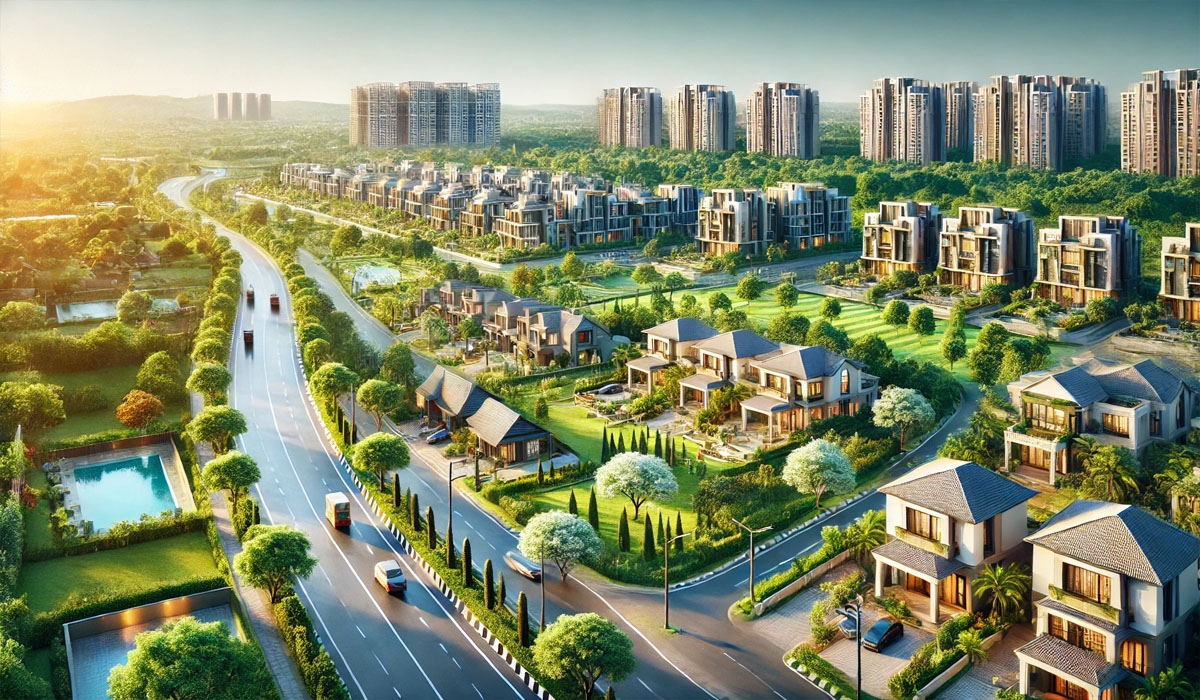Chandigarh: The Tricity real estate market (Chandigarh, Mohali, and Panchkula) is set for continued expansion over the next five years, with experts predicting strong demand, rising property values and increasing investor interest. Fueled by Infrastructure upgrades, economic growth, and a shift toward luxury and sustainable living, the region remains a hotspot for real estate activity.
♦ Factors contributing to Positive Growth
1. Infrastructure Development: The Tricity region has been experiencing significant infrastructure upgrades, such as improved road networks (e.g., the PR-7 Airport Road), proximity to Chandigarh International Airport, and plans for enhanced public transportation like electric buses. These developments improve connectivity to major cities like Delhi and Shimla, making the area more attractive to homebuyers and investors. Chandigarh’s administration has also announced projects worth Rs. 2.73 billion for FY 2025, including over 600 government housing units and a new Police Training Centre, which are expected to boost demand in both residential and commercial sectors.
2. Economic and Employment Growth: Mohali’s emergence as an IT hub, with companies like Infosys and Dell setting up operations, is driving demand for residential and commercial properties. The presence of industrial zones and Special Economic Zones (SEZs) is attracting professionals, increasing housing needs. Chandigarh’s status as a Union Territory and the capital of Punjab and Haryana adds to its economic stability, further supporting real estate growth.
3. Rising Demand for Luxury and Sustainable Housing: There’s a notable shift toward luxury homes and sustainable living in Tricity. Luxury housing prices have reportedly surged by 15-20% recently, fueled by interest from Non-Resident Indians (NRIs) and professionals. Developers are integrating eco-friendly designs, which align with growing buyer preferences, potentially sustaining premium pricing over time.
4. Historical Price Trends: Property prices in Chandigarh have nearly doubled in the past five years, with one-kanal houses in prime sectors rising from Rs. 8 crore pre-2020 to Rs. 15-16 crore by late 2024. Flats in southern sectors have also seen 60-100% increases. This upward trajectory suggests a strong market, though growth may moderate as it matures.
5. Population and Investment Inflow: The region is attracting high-net-worth individuals (HNWIs) and families from neighboring states like Punjab, Haryana, and Delhi, partly due to its high quality of life and urban planning. This influx, combined with investments in real estate as a means to park wealth, supports price appreciation.
♦ Challenges to watch:
1. Affordability Concerns: Rapid price increases have made properties less affordable for the middle class, potentially slowing demand in certain segments. For instance, residential prices in prime areas like Sector 8-10 range from INR 7,000-12,000 per square foot, while plots can reach INR 70,000-1,20,000 per square yard, pricing out some buyers.
2. Market Saturation Risk: Some observers on platforms like Reddit have suggested that the doubling of property prices every two years could indicate a bubble, especially if economic productivity doesn’t keep pace with price growth. Tricity remains a Tier-2 region with limited expansion scope due to its planned design, which might constrain supply and inflate prices unsustainably.
3. Economic Variables: Broader economic factors, such as interest rates, inflation, and national policy changes (e.g., under a new administration), could impact mortgage affordability and buyer sentiment. While India’s housing finance market is projected to double to USD 928 billion in five years, any unexpected economic slowdown could temper this growth.
♦ Outlook for 2025-2030
Price Growth: Over the next five years, real estate prices in Tricity are likely to see moderate to strong growth, averaging 5-10% annually, depending on the segment. Luxury and prime-location properties may outpace this at 10-15% yearly, driven by NRIs, HNWIs, and infrastructure momentum. Affordable and mid-segment housing might grow more slowly (4-7%) as developers respond to affordability pressures with new projects.
Residential: Demand for flats, villas, and plotted developments in areas like New Chandigarh, Mullanpur, and Zirakpur (which saw 50-70% appreciation in the last three years) should persist, supported by population growth and job opportunities. Sustainable luxury homes will likely command premium prices.
Commercial: Mohali’s IT and industrial growth will boost demand for office spaces, co-working hubs, and retail complexes, especially near Aerocity and Sector 67. Prices here could rise steadily as businesses expand.
Regional Variations: Chandigarh’s northern sectors (e.g., 8-11) and Mohali’s IT-centric zones may see higher appreciation due to prestige and economic activity. With its scenic appeal and luxury projects, Panchkula could attract steady investment, though at a slightly slower pace.
Stabilization Possibility: By 2028-2030, growth might stabilize as the market matures, particularly if supply increases through new construction (e.g., government housing initiatives) or if demand softens due to high prices. Peripheral areas like Zirakpur and Kharar could see higher appreciation potential as they remain relatively affordable compared to Chandigarh’s core.
♦Conclusion
The outlook for real estate prices in Tricity near Chandigarh over the next five years is generally positive, with sustained growth expected due to infrastructure, economic development, and shifting buyer preferences toward luxury and sustainability. However, the pace of appreciation may moderate compared to the past five years, settling into a more sustainable range. Investors and buyers should focus on emerging micro-markets (e.g., New Chandigarh, Aerocity Mohali) for higher returns while monitoring affordability and economic trends that could introduce variability. Given the region’s dynamic market conditions, consulting a local real estate expert for personalized insights is advisable.

